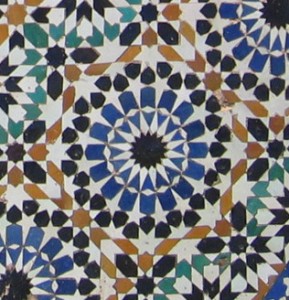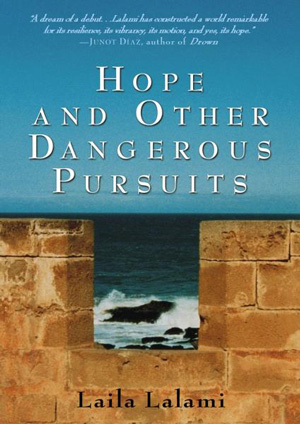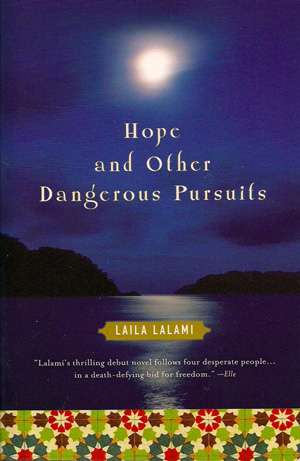
 In this issue our readers' Conversation is about the stimulating and graceful Hope and Other Dangerous Pursuits
by Moroccan-born writer, linguist, and critic, Laila Lalami. This impressive debut was published in the US in 2005,
and has since been translated into 6 languages.
In this issue our readers' Conversation is about the stimulating and graceful Hope and Other Dangerous Pursuits
by Moroccan-born writer, linguist, and critic, Laila Lalami. This impressive debut was published in the US in 2005,
and has since been translated into 6 languages.
As a Moroccan based in the United States, Lalami often noticed stories buried deep in the pages of newspapers reporting on the desperate acts engaged in by poverty-stricken Moroccans who had escaped from their homeland because they viewed immigration as a magical solution to their myriad problems. More often than not, they met with disastrous consequences. Lalami's interest in illegal immigrants and all that it entailed led to research and the eventual publication of Hope and Other Dangerous Pursuits.
The book is set in modern-day Morocco and opens as a small boat makes its way across the Strait of Gibraltar, at night, carrying about 30 illegal emigrants from Morocco to Spain. Just before the boat reaches the Spanish coast the passengers are all made to leave the boat, and are left in the water to find their own way to the shore. Some of them drown, some are caught by the police, and some reach the shore with grand hopes of a life and work in a more prosperous country. This introductory section is followed by the stories of four of the people who have made it safely ashore.
A gentle warning before you jump in: we discuss the entire book here so if you want to avoid spoilers, you may read the book first and then come back to the conversation.
Participating:
Jenny, a nurse from New South Wales, Australia
Margaret, a Brit currently living in Taipei, Taiwan
Michael, a scientist from the Northeastern United States

 Michael: I thought Hope and Other Dangerous Pursuits did a great job of showing the variety of reasons
why people might want to emigrate. Each character had his or her story, yet they all wound up on that boat.
Some were pushed by their circumstances, while others were pulled by opportunity and also pushed by a lack of
opportunity in Morocco.
Michael: I thought Hope and Other Dangerous Pursuits did a great job of showing the variety of reasons
why people might want to emigrate. Each character had his or her story, yet they all wound up on that boat.
Some were pushed by their circumstances, while others were pulled by opportunity and also pushed by a lack of
opportunity in Morocco.
Margaret: I enjoyed the book. It was a very easy read and the characters and their environments were vividly
portrayed. It got off to an excellent start with the short sequence in the boat, which I found quite nerve-racking!
My favourite part, however, was the section that dealt with what happened after the boat journey. This isn't a
spoiler because the chapter headings at the start of the book are "Before" and "After".
I've read a number of books that deal with this type of story, so the journey itself and what led up to it were not
really anything new. But seeing what happened to the characters afterwards put the story of the journey into
perspective. The boat journey was one thing that had happened in these people's lives, but it wasn't necessarily
the defining thing. This made them seem like more rounded characters, not just illegal immigrants, but real people
who had all sorts of things going on in their lives.
Michael: Margaret, that's a good point. There are other novels that start with something dramatic, and then go on to tell how the characters got to that point, but I can't think of another with this before-and-after form. I think that the emigration motif is what ties together these four very different stories.
Jenny: For such a slim novel Lalami has written a powerful story. I enjoyed it very much and the prose was quite
lovely, too. I have to agree with Margaret. I, too, liked the structure of the book, beginning with the boat
journey. I was pulled in immediately and wanted to know what circumstances would make people so desperate that
they would attempt such a perilous journey.
With regard to the structure of the book, it could be read as a novella, or a collection of short stories. How it
did strike you?
Margaret: That is a really good question. I didn't really think about it when I was reading the book, but Michael's statement made me realise that the narratives feel like short stories, in that apparently insignificant events seem to have more weight that you might expect e.g. Fateh's decision to cook dinner for Betoul. Also, they are like short stories in the way they end with the future sort of poised on a possible change. I liked that.
Michael: I find I'm wondering what happened to each character, after their stories ended. Do we wish Lalami
had written a longer book, giving us more on each character? I do.
I really want to see more of the story of Halima's son Farid, the unwilling saint, don't you? That can't end well,
I think, though things were working out well, at our last view.
Margaret: I don't particularly wish that we had a longer book with more on each character, because I think
that would be quite a different book. I can't imagine these narratives being the start of a longer story.
Did you think you got a vivid picture of Morocco from the story?
Michael: I don't often wish for a book to be longer but this time I did. To be sure, that would then be a
very different novel.
As to the picture of Morocco, there are aspects that are vivid: the extensive corruption, the absence of opportunity,
and so on. I was also struck by how tourists arrived there, already seeing Morocco through a lens provided by the
writings of Westerners. How frustrating that must be for someone who grew up there!
Similarly, as an American living near Boston, I've been asked on the subway for directions to the well-known bar in
the television series, "Cheers", an imaginary place with little relation to the real city, but which now has a
physical presence there. This sort of thing is common. We seem unable to see a place for itself, so it's great
that Lalami gives us a different lens on Morocco.
I was also interested to learn that Moroccans can see Spain, its houses and roads, across the Straight, which is
only 14km wide. All that wealth in view to be reached by a simple, but dangerous, boat trip.
Jenny: I find it fascinating that one is able to see Spain from Morocco. One can see the appeal, when potential freedom and opportunity are so close. The illegal immigrant debate is always on the agenda politically, here in Australia. Being geographically remote, those that finally make it to our shores, by way of boat, have come a very long way.
Michael: Of course, people see pictures of their destinations and hear things from emigrants who went before;
but it must be especially difficult to see it right there, all the time.
Seems to me that the two characters who don't make it to Spain end up with rather better outcomes than they had
expected. And the two who do get there discover that it's not what they had hoped for, at all. What do we think
about this difference—if I'm right about it?
 Margaret: On the story of Farid, I wondered whether there was a connection between people's belief in
miraculous powers (his, or of the magic bleeding tree) and the perceptions of what would happen if people could
make it overseas. There was a sense that people knew the voyage itself was dangerous but that once you were there,
your problems would be solved.
Margaret: On the story of Farid, I wondered whether there was a connection between people's belief in
miraculous powers (his, or of the magic bleeding tree) and the perceptions of what would happen if people could
make it overseas. There was a sense that people knew the voyage itself was dangerous but that once you were there,
your problems would be solved.
Were you able to empathise with the characters? Were they well-rounded? Did you favor any one character or story
above another? Why?
Michael: Margaret, on the connection between Farid's magic and the magic of emigration: I didn't think to
look around those particular corners. Good idea!
I thought each character was very well-rounded, especially considering the relatively short space (about 45 pages?)
each had.
I have to go with Murad as my favorite. I enjoyed his take on the silly tourists who come to see Paul Bowles relics
and I loved that, at the end, he came up with a way to make the best of his situation. I'd also like to put a word
in for Larbi Amrani (not one of our four protagonists), the excessively comfortable government official who drives
Faten out of Morocco. He represents much of Morocco's problem, clearly, but Lalami draws him very sympathetically.
He has his reasons, and I fear I might do the same, in his place.
Margaret: Yes, I liked Larbi, too. It was an interesting decision to present Faten's 'before' story from
his point of view. I found myself wondering whether the Faten on the boat would turn out to be his daughter, taking
on her friend's name to avoid detection. But I think that made it harder to feel a connection with her character—by
the time you saw her in the 'after' she was quite resigned to her situation, so there was less sense of the changes
she had gone through.
I am not sure I would say that the characters were exactly well-rounded, but they were not caricatures or
two-dimensional. There were enough little human details to give you a sense of them as real people. The same,
I think, is the case with other characters in each story. For example, the way that Betoul saves up all her money
to spend once a year when she goes home.
Jenny: I agree that Lalami did a good job of creating her characters in very few pages, and I got a real
sense of the factors that influenced each one of them by way of the socio-economic, religious and emotional drive
for the change that they were looking for in their lives.
I felt empathy particularly for Faten. The description of her in the beginning, where she is sitting in the boat
is our first glimpse of her wearing the hijab where she is clearly a devout college girl ("The Fanatic") persuading
other girls to follow her example. Then, on making it to Spain, she works as a prostitute to support herself and
"wonders about the price of all this—after all, she had learned long ago that nothing was for free." One
realises that this is not the real Faten, and that she wasn't a fanatic either. Her struggle and her circumstances
are really chilling.
Margaret: I liked how Faten's two chapters were entitled, "The Fanatic" and "The Odalisque" … the old cliché and the new one.
Michael: So maybe we never see the actual Faten; even in Spain, she has to accept the definition of herself that her customers want to see.
Jenny: I'd like to ask a question in relation to Aziz and his return to Morocco. Would this have been likely? When you enter a country illegally, would you risk detection by returning? This just didn't ring true for me. What do you think?
Margaret: This didn't especially bother me. I just thought that he had been in Spain long enough to get his papers sorted out.
Michael: Aziz's return does seem to imply an improbable level of confidence in his false papers.
Margaret: A last question from me about the title. Did you feel hopeful at the end of this book?
I did, but it's a sort of qualified hope. In many ways, it's hopeful because one feels that people are pretty
adaptable and can make the best of almost any situation, if they have to. But perhaps, they are able to make
the best of the situation because they have lost the hope of something better. In the 'before', they are hoping
to change their lives by crossing the Strait, so they are unable to make the best of things.
Michael: Again, it seems that the stay-at-homes did a bit better. I do feel hopeful for Murad, who at least
has something he wants to do at the end. The other three seem to be in for various amounts of grief.
To round up: We seem to have considered a number of aspects of this fine book. I've certainly learned a few things
about it that I did not consider while reading it. I think a reader would be well-rewarded by picking it up.
Jenny: I expect it hasn't been the author's intention to change minds about illegal immigrants, but I think
it is an important book. Governments manipulate the media in order to distance the public from feeling empathy for
those seeking asylum; and we never get a sense of these people as being human. So anyone with mixed feelings about
this issue would do well to see the world through Lalami's characters, just for a while.
About the title, when I picked up Hope and Other Dangerous Pursuits, I had no idea what to expect. I think
the title is too open, in that it didn't give me any hint about the people involved in the story.
Michael: Lalami's characters are not at all exotic, so really anyone who likes good fiction should try this out. You should be able to empathize with others' troubles, but any steady novel reader can do that. Hope is what drives her characters—and everyone else—right?
Margaret: I agree. I think a lot of readers would enjoy this book, but if I had to pick one kind, I would
say people who like short stories, because of the way each narrative ends in the place a short story would end.
Unlike Jenny, I loved the title. Already you are thinking about questions: How dangerous is it to have hope? How
necessary? And then you are plunged right into the danger with the start of the story, so it helps you think,
while reading, just why those people are in that situation.
As a final word, I want to thank you for your participation in this discussion. It has definitely made me think about
aspects of the book I missed on the first reading. I have really enjoyed it!

Laila Lalami is Associate Professor of Creative Writing at the University of California and currently lives in Los Angeles. She has a blog at: http://lailalalami.com/blog/.
Hope and Other Dangerous Pursuits by Laila Lalami is published by Mariner Books (paperback) and Algonquin Books (hardcover). This book and her 2009 novel Secret Son is available in both hardcover and paperback from Algonquin Book or your local bookseller.
If you'd like to participate in one of our future conversations, send us a note at editor [at] belletrista.com.
